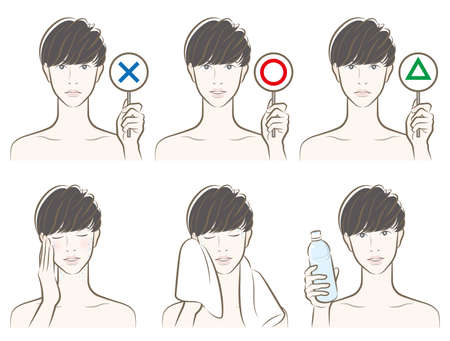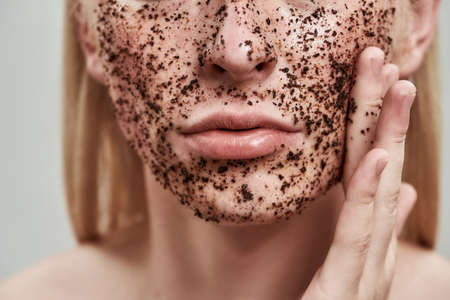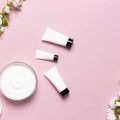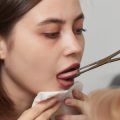1. What Causes Acne and Why It’s So Common in the U.S.
Acne is one of the most common skin concerns in the United States, affecting people of all ages—from teenagers to adults. Understanding what causes acne is the first step toward finding an effective treatment plan. In this section, we’ll explore the key factors that contribute to breakouts, especially those linked to American lifestyles.
Hormonal Changes
Hormones play a major role in acne development. During puberty, the body produces more androgens (male hormones), which trigger oil glands to produce more sebum. This excess oil can clog pores and lead to acne. Hormonal fluctuations also affect women during menstruation, pregnancy, or while using birth control.
Diet and Nutrition
While everyones skin reacts differently to food, studies suggest that certain elements of the typical American diet may contribute to acne flare-ups. High consumption of processed foods, sugary snacks, and dairy products can increase inflammation and oil production.
Foods That May Trigger Acne:
| Food Type | Common Examples | Why It Might Cause Acne |
|---|---|---|
| Sugary Foods | Soda, candy, pastries | Spikes blood sugar and insulin levels, increasing oil production |
| Dairy Products | Milk, cheese, ice cream | May influence hormone levels and inflammation |
| Fast Food | Burgers, fries, fried chicken | High in unhealthy fats and refined carbs that can worsen acne |
Stress Levels
Life in the U.S. can be fast-paced and stressful—whether its school, work, or social pressure. Chronic stress can lead to hormonal imbalances that stimulate oil glands and increase inflammation, both of which are linked to acne flare-ups.
Environmental Factors
The environment also plays a role in skin health. In many parts of the U.S., pollution levels are high, especially in urban areas. Pollution can clog pores with dirt and toxins. Additionally, frequent use of air conditioning or central heating can dry out the skin, causing it to overproduce oil as compensation.
Common Environmental Triggers in the U.S.:
- Pollution: Smog and dust particles clog pores and irritate the skin.
- Climate-Controlled Indoors: Air conditioning/heating dries out skin.
- Hard Water: High mineral content may disrupt skin’s natural barrier.
- Overuse of Skincare Products: Many Americans try multiple products at once, which can overwhelm sensitive skin.
By understanding how these factors contribute to acne—especially in a U.S.-specific context—you can begin to make lifestyle adjustments that support clearer skin.
2. Types of Acne: Identifying What Youre Dealing With
Not all acne is created equal. Understanding the different types can help you better treat and manage breakouts. In the U.S., where skincare routines and products vary widely, recognizing what kind of acne youre dealing with is the first step to clearer skin. Heres a breakdown of the most common types of acne:
Comedonal Acne
Blackheads (Open Comedones)
These are small, dark spots that appear when pores get clogged with oil and dead skin cells but remain open at the surface. The black color isn’t dirt—it’s oxidation.
Whiteheads (Closed Comedones)
Similar to blackheads, whiteheads occur when pores are clogged with oil and dead skin cells, but the pore remains closed, creating a small bump under the skin.
Inflammatory Acne
Papules
Small, red bumps that may feel sore or tender. These form when blocked pores become inflamed due to bacteria buildup.
Pustules
These look like whiteheads with a red ring around them. They contain pus and are more inflamed than regular comedones.
Severe Acne
Nodules
Large, painful lumps deep under the skin. Nodules don’t usually have a head and are harder to treat with over-the-counter products.
Cystic Acne
The most severe type of acne. Cysts are large, pus-filled lesions that can be painful and cause scarring. This type often requires treatment by a dermatologist in the U.S., sometimes including prescription medication or procedures.
Acne Types at a Glance
| Type | Description | Severity | Treatment Approach |
|---|---|---|---|
| Blackheads | Clogged open pores with dark surface | Mild | OTC cleansers with salicylic acid or retinoids |
| Whiteheads | Clogged closed pores forming small bumps | Mild | Benzoyl peroxide, retinoids, gentle exfoliation |
| Papules | Small red, inflamed bumps without pus | Moderate | Benzoyl peroxide, topical antibiotics, retinoids |
| Pustules | Bumps filled with pus and surrounded by redness | Moderate | Benzoyl peroxide, salicylic acid, spot treatments |
| Nodules | Larger, deep-seated painful lumps under the skin | Severe | Prescription treatments from a dermatologist |
| Cysts | Painful, pus-filled lesions deep in skin layers | Severe | Oral medications, dermatologist procedures like cortisone shots or Accutane®* |
*Accutane® is a brand name for isotretinoin, a powerful prescription acne treatment used in severe cases.
If you can identify your acne type, it becomes much easier to choose the right products and know when its time to see a professional in the U.S. skincare system.

3. Best Over-the-Counter Treatments Available in the U.S.
When it comes to treating acne without a prescription, there are tons of over-the-counter (OTC) options available at major U.S. retailers like Target, Walgreens, CVS, and Ulta. These products are easy to access and can be very effective for mild to moderate acne. Let’s break down some of the most popular types of OTC treatments you’ll find on American shelves.
Cleansers
Cleansers are a great first step in any skincare routine. They help remove dirt, oil, and makeup while treating acne with active ingredients like salicylic acid or benzoyl peroxide.
| Brand | Product Name | Key Ingredient | Skin Type |
|---|---|---|---|
| CeraVe | Acne Foaming Cream Cleanser | Benzoyl Peroxide (4%) | Normal to Oily |
| Neutrogena | Oil-Free Acne Wash | Salicylic Acid (2%) | Oily & Acne-Prone |
| La Roche-Posay | Effaclar Medicated Gel Cleanser | Salicylic Acid (2%) | Sensitive Skin |
Spot Treatments
If you have a few stubborn pimples, spot treatments can help reduce their size and redness quickly. These are usually more concentrated formulas meant for targeted use.
| Brand | Product Name | Main Ingredient | Best For |
|---|---|---|---|
| Clean & Clear | Advantage Acne Spot Treatment | Salicylic Acid (2%) | Pimples & Blackheads |
| ZitSticka | KILLA Kit Spot Treatment Patch + Microdart Serum | Niacinamide + Salicylic Acid | Cystic Acne & Early-Stage Pimples |
| The Ordinary | AHA 30% + BHA 2% Peeling Solution* | AHA/BHA Blend* | (Use with caution – weekly treatment) |
Acne Patches
Pimple patches are a newer favorite among teens and adults alike. These small stickers go directly on your blemish and absorb pus and oil while protecting it from bacteria and picking.
| Brand | Name | Main Feature | ||||||||||||||||||||||||||||||||||||||||
|---|---|---|---|---|---|---|---|---|---|---|---|---|---|---|---|---|---|---|---|---|---|---|---|---|---|---|---|---|---|---|---|---|---|---|---|---|---|---|---|---|---|---|
| Mighty Patch by Hero Cosmetics | Mighty Patch Original | Hydrocolloid-based; drug-free healing overnight | ||||||||||||||||||||||||||||||||||||||||
| COSRX | Acne Pimple Master Patch | K-beauty cult favorite; works well under makeup too | ||||||||||||||||||||||||||||||||||||||||
| Nexcare | 4. When to See a Dermatologist and What to Expect
| Treatment Type | Description | How It Helps |
|---|---|---|
| Topical Prescription Medications | Includes retinoids, antibiotics, or benzoyl peroxide combinations | Targets clogged pores and reduces inflammation |
| Oral Antibiotics | Pills like doxycycline or minocycline | Reduces bacteria and inflammation from the inside out |
| Hormonal Treatments | Birth control pills or spironolactone (for women) | Helps regulate hormones that trigger acne breakouts |
| Isotretinoin (Accutane) | A powerful oral medication for severe or cystic acne | Can lead to long-term remission of acne but requires close monitoring due to side effects |
| In-Office Procedures | Chemical peels, laser therapy, light therapy, or cortisone injections | Used for faster results or treating stubborn acne lesions and scarring |
Insurance and Cost Considerations in the U.S.
If you have health insurance, many plans cover dermatology visits, especially when referred by your primary care doctor. However, coverage varies widely depending on your provider and plan. Without insurance, a visit can range from $100 to $200+, not including prescriptions or procedures. It’s always smart to call ahead and ask about costs before booking an appointment.
Tip:
If youre worried about cost, look into community clinics or teledermatology services—they often provide more affordable options with licensed professionals.
The Bottom Line on Seeing a Derm in the U.S.
If your acne is persistent, painful, or emotionally draining, don’t wait—U.S. dermatologists offer customized solutions that go far beyond what store-bought products can do. Getting expert help can make all the difference in achieving clear, healthy skin.
5. Lifestyle Changes That Can Clear Your Skin
When it comes to managing acne, what you do outside of your skincare routine matters just as much as the products you use. Daily habits like what you eat, how often you move your body, and how well you sleep can all impact your skin health. Here’s how making a few lifestyle tweaks—based on typical American routines—can help clear up breakouts.
Eat Smart for Clearer Skin
Diet plays a big role in how your skin behaves. While greasy foods don’t directly cause acne, diets high in sugar and processed carbs can trigger breakouts by increasing insulin levels and inflammation. Try incorporating more whole foods into your meals—think fruits, veggies, lean proteins, and healthy fats.
| Foods to Limit | Skin-Friendly Alternatives |
|---|---|
| Sugary drinks (soda, sweet tea) | Infused water or herbal tea |
| White bread and pastries | Whole grain bread and oatmeal |
| Dairy (especially skim milk) | Almond or oat milk (unsweetened) |
Get Moving: Exercise Helps More Than You Think
Regular physical activity helps improve blood circulation, reduce stress hormones like cortisol, and promote hormonal balance—all of which are key to healthy skin. Aim for at least 30 minutes of moderate exercise five days a week. This could be a brisk walk around your neighborhood, a spin class at the gym, or even dancing in your living room.
Quick Tip:
Always shower and cleanse your face after working out to prevent sweat from clogging pores.
Make Sleep a Priority
Lack of sleep can increase inflammation in the body and lead to higher stress levels, both of which can worsen acne. Most adults in the U.S. need about 7–9 hours of quality sleep each night. Try setting a consistent bedtime—even on weekends—and limit screen time before bed.
Sleep Hygiene Tips:
- Keep your bedroom cool and dark
- Avoid caffeine after 3 p.m.
- Create a relaxing bedtime routine (like reading or taking a warm bath)
Reduce Everyday Stress
Stress doesn’t directly cause acne but it can make it worse by triggering hormonal changes that increase oil production. American life is busy—between work, family, and everything else—but finding ways to manage stress can lead to clearer skin.
Simple Stress-Relief Ideas:
- Practice deep breathing for 5 minutes daily
- Try guided meditation apps like Calm or Headspace
- Squeeze in short breaks during the day to stretch or take a walk
Tweaking your daily habits doesn’t have to mean overhauling your entire lifestyle. By making small, manageable changes that fit into your everyday routine, you can support healthier skin from the inside out.
6. Understanding Acne Stigma and Building Confidence
Acne is more than just a skin condition—it can affect how you feel about yourself. In the U.S., where beauty standards are often shaped by flawless, filtered images on social media and in advertising, having acne can make people feel self-conscious or even ashamed. But it’s important to know that acne is incredibly common and nothing to be embarrassed about.
The Emotional Impact of Acne
Dealing with breakouts can take a toll on your mental health. Whether its avoiding photos, skipping social events, or feeling anxious about how others perceive you, these reactions are normal—but they don’t have to define your self-worth.
Common Emotional Challenges:
| Emotional Effect | Description |
|---|---|
| Anxiety | Worrying about what others might think of your skin. |
| Low Self-Esteem | Losing confidence due to visible breakouts. |
| Avoidance Behavior | Cancelling plans or avoiding mirrors and photos. |
Busting Common Acne Myths
Misinformation about acne is everywhere. Let’s clear up some of the most common myths so you can focus on facts—not fear.
Top Acne Myths vs. Facts:
| Myth | The Truth |
|---|---|
| You get acne because youre dirty. | Nope! Acne isnt caused by poor hygiene—its linked to hormones, oil production, bacteria, and inflammation. |
| Sunscreen makes acne worse. | The right sunscreen (non-comedogenic) actually protects your skin without clogging pores. |
| You should pop pimples to get rid of them. | Popping can lead to scarring and infections. It’s better to treat them gently with proven products. |
Embracing Your Skin While Working Toward Clearer Results
Your journey with acne doesn’t need to be all-or-nothing. You can care for your skin while also learning to appreciate it as it is today. Here are a few ways to boost your confidence along the way:
Tips for Building Confidence:
- Acknowledge progress: Even small improvements matter—celebrate them!
- Create a skincare routine you enjoy: A few minutes of self-care each day adds up mentally and physically.
- Avoid comparison: Everyone’s skin is different; don’t judge your journey by someone else’s highlight reel online.
- Tune into positive voices: Follow influencers or communities that promote real skin and confidence at every stage.
You deserve to feel good in your skin—whether you’re dealing with breakouts or not. By understanding the emotional impact of acne, letting go of harmful myths, and focusing on healthy habits, you’re already taking powerful steps toward both clearer skin and greater self-confidence.


